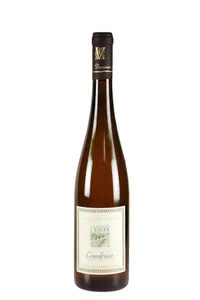Free delivery from Fr. 300 of purchase or 18 bottles, otherwise Fr. 15

Nothern Côtes du Rhône
Northern Côtes du Rhône
Between Vienne and Avignon, over a distance of about 200 km, the Rhone vineyard spreads its numerous appellations along the eponymous river. Concerning the northern part, we are here in one of the cradles of wine growing. These vineyards, located between Vienne and Cornas were undoubtedly, as early as the end of the 1st century BC, the source of the famous vinum picatum which the Romans were particularly fond of.
Côte-Rôtie
Located on the right bank of the Rhône, a stone's throw from Vienne, it is one of the region's jewels. Its steep slopes are one of the chosen areas for syrah, or serine. From a pedological point of view, the northern part is based on micaschists and produces deep, spicy, full-bodied wines that need time to develop.
Condrieu
The white twin of Côte-Rôtie, the appellation almost disappeared ! Phylloxera, the First World War, the crisis of the 1930s and the industrialisation of the valley almost led to its abandonment. In the 1950's, there were only about ten hectares left cultivated in Condrieu, Vérin and Saint-Michel. Maintained all the same by a few passionate winegrowers, including Georges Vernay, the vineyard was reborn in the 1980s. On granite and gneiss soils, the exuberant Viognier is adorned with a subtlety and freshness that is only known here, with the added bonus of a much greater ageing potential than has long been claimed.
Saint-Joseph
From Chavanay in the north to Guilherand in the south, the appellation's vineyard stretches for some 50 kilometres on the right bank of the Rhône. It covers 23 communes in the Ardèche and 3 in the Loire. It is planted on steep slopes, shaped into terraces since ancient times. Formerly called "Vin de Mauves", it was the Jesuits who, in the 17th century, gave it its current name. The appellation is known for its fragrant and more or less structured Syrahs depending on the soil and its rich and textured Roussanne and/or Marsanne whites.
Hermitage
This is one of the most prestigious appellations in France. The total area of the appellation (130 ha) was delimited in 1937 by judgment and is not expandable. From a pedological point of view, the vineyard shows an exceptional diversity of soils. Originally, the hill of Tain is a block of porphyroid granite detached from the Massif Central. It can be divided into 3 parts: the original Tournon granite formation on the west side, which includes the Bessards and La Chapelle districts; loess soils found more on the upper part of the hill; and finally various formations resulting from the river terraces of the Rhône. In all cases, a red Hermitage is a wine for long ageing, with more spice and structure if it comes from a granitic matrix, or more fruit and sweetness if it comes from the other types of soil. In whites, if the vinification and maturation have not worn out the raw material, one can appreciate in time opulent but fine, gastronomic wines!
Crozes-Hermitage
About a stone's throw from the hill of Hermitage unfolds the largest vineyard of the northern appellations, on 11 communes of the Drôme. A cru-challenger, it is made from the same grape varieties as Saint-Joseph. The northern sector touches Hermitage and is based on granitic rock. It produces rather structured and spicy wines, to be kept. The rest of the appellation gives more immediate and greedy wines, but not necessarily less profound. In white, the wines are rich, tender and spontaneous, and can be drunk young.
Cornas
Located "south of north" this characterful cru is one of the most fascinating ever. The vineyard is located on the western slope of the Massif Central, in the commune of the same name. The steep slopes, facing east and south-east, form natural amphitheatres which protect the vines from the Mistral. Syrah, the appellation's only grape variety, expresses all its wild originality here, but without losing its finesse when the granite is allowed to express itself.
49 items

IGP Col. Rhodaniennes, Syrah Monestiers, David Reynaud - 2021
IGP Collines Rhodaniennes

IGP Syrah, Fleurs de Mai, Georges Vernay - 2021
IGP Collines Rhodaniennes

IGP Collines Rhodaniennes, Sainte Agathe, Georges Vernay - 2021
IGP Collines Rhodaniennes

Condrieu Les Chaillées de l'Enfer, Georges Vernay - 2022
Condrieu

Condrieu Les Chaillées de l'Enfer, Georges Vernay (magnum) - 2022
Condrieu

St-Joseph Terres d'Encre, Georges Vernay - 2022
St-Joseph

St-Joseph La Dame Brune, Georges Vernay - 2021
St-Joseph

Côte Rôtie Maison Rouge, Georges Vernay - 2021
Côte-Rôtie

Coffret 3 bts Condrieu La Grillette (2018, 19, 20), Dom. du Monteillet
Condrieu

Côtes-du-Rhône, L'Enclave, Jean-Luc Jamet - 2021
Côtes du Rhône

Crozes-Hermitage Silène, J.L.Chave Sélection - 2022
Crozes-Hermitage

Crozes-Hermitage, Les Coulaires, Vendome - 2022
Crozes-Hermitage